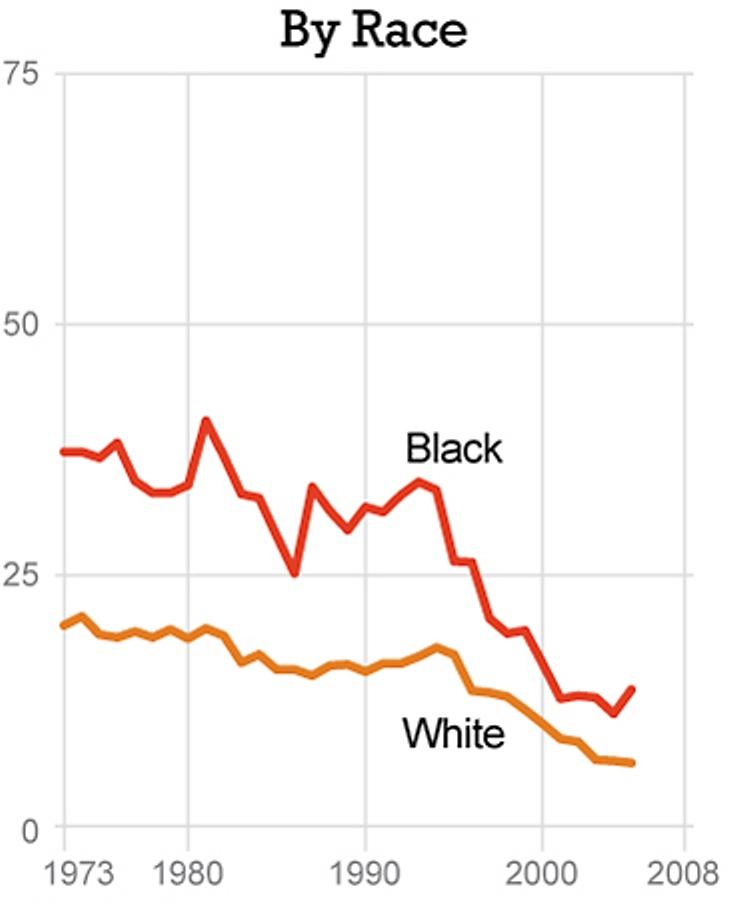
The Myth of the Black-on-Black Crime Epidemic
Crime is a component of poverty, opportunity, & proximity—not racial pathology.

It’s great to see people (like those here, here, and here), many of whom advocate cuts to institutions and policies proven to curb crime like community groups, education, and job training, finally noticing that crime in Black communities is a problem that should be addressed. However, they are 20 years late. While they slept, African-American community leaders, parents, churches, and activists having already noticed the problem have been tirelessly working to make the communities they love safer. Jamelle Bouie recently wrote poignantly how Black-on-Black crime is being falsely framed as a distinctly African American pathology rather than a component of poverty, opportunity, & proximity. If America is to have this much touted ‘conversation’ on race, it is important the dialogue itself adhere to the guiding principal of being rooted in facts.
For many years, countless poor African Americans across the country tried to draw attention to high crime rates, guns, gang activity, and drug abuse that pervaded their neighborhoods. The Black urban poor, through community institutions, churches, and individual efforts were most often met with neglect, divestment of private and public resources, and outright disdain. I witnessed firsthand, growing up in Camden, New Jersey in the 1980’s, how the surrounding suburbs, state, and federal governments ignored Black victims of crime and dismissed whole urban areas as havens of pathologically violent criminals. Residents suffered as the ‘War on Poverty’ became the ‘War on Drugs’ and incarceration rates skyrocketed while social services, education, and urban infrastructure funds were slashed.
It is within this context that I’ve marveled and cringed at recent dialogue about crime, discrimination, and inequality in the criminal justice system. From conservatives opining President Obama acted too ‘black’ by speaking of his experiences to progressives arguing he was not being ‘black’ enough by having insufficiently explicit rhetoric and policies targeting the problems of African Americans. The most amusingly bewildering aspect of this rhetoric is how assertions of racial inequalities in the American criminal justice system have immediately are rebutted by pointing to the ‘genocide’ of Black-on-Black urban crime. This focus, from many of the same political quarters who ignored the problem at its peak, belies the facts of both the causes and trends of Black-on-Black crimes.
Black on Black Crime Facts
- Black-on-Black homicides have decreased by 67% in 20 years, a sharper rate of decrease than white on white homicide.
- According to FBI statistics 7361 Blacks were killed by fellow African-Americans in 1991. In 2011, it dropped dramatically to 2447 African-Americans.
- Among Black youth, rates of robbery and serious property offenses are the lowest in more than 40 years.
Racial Inequality in the Criminal Justice System Facts
- African Americans were two times as likely to be arrested and almost four times as likely to experience the use of force during encounters with the police.
- In the federal system Black offenders receive sentences that are 10% longer than white offenders for the same crime.
- Five times as many Whites are using drugs as African Americans, yet African Americans are sent to prison for drug offenses at 10 times the rate of Whites.
- African Americans are incarcerated at nearly six times the rate of Whites.
- African American juvenile youth are about 16% of the youth population, 37% of their cases are moved to criminal court & 58% of convicted African American youth are sent to adult prisons.
- Controlling for other factors, including severity of the offense and prior criminal history, white men aged 18-29 were 38% less likely to be sentenced to prison than their Black male peers.
- African American women are three times more likely than white women to be incarcerated.
- African American defendants are 21% more likely to receive mandatory-minimum sentences than Whites and are 20% more like to be sentenced to prison.
While it is essential that we address the high levels of violence and incarceration in America compared to other industrialized countries, we cannot accurately do so by perpetuating the myth of a uniquely African American pathology toward violence and crime. Instead of denying the downward trends in crime in the Black community, we must applaud it and reward it with a serious examination of racial inequality in the American criminal justice system. Although, I am not sure whether our new found defenders of the Black community would agree.


